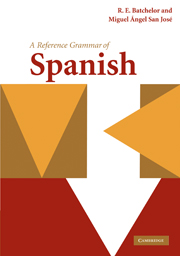Book contents
- Frontmatter
- Contents
- Preface/Prólogo
- Acknowledgments/Agradecimientos
- Abbreviations/Abreviaturas
- Introduction to the Spanish language/Introducción a la lengua española
- Part I
- Part II
- 7 Definite article/Artículo definido
- 8 Indefinite article and indefinite pronoun/Artículo indefinido y pronombre indefinido
- 9 Gender/Género
- 10 Number (singular and plural)/Número (singular y plural)
- Part III
- Part IV
- Part V
- Part VI
- Part VII
- Part VIII
- Part IX
- Part X
- Appendix I Verb tables/ Tablas de verbos
- Appendix II Glossary/Glosario
- Bibliography/Bibliografía
- General index/Índice general
- Subjunctive index/Índice del subjuntivo
9 - Gender/Género
from Part II
Published online by Cambridge University Press: 05 June 2012
- Frontmatter
- Contents
- Preface/Prólogo
- Acknowledgments/Agradecimientos
- Abbreviations/Abreviaturas
- Introduction to the Spanish language/Introducción a la lengua española
- Part I
- Part II
- 7 Definite article/Artículo definido
- 8 Indefinite article and indefinite pronoun/Artículo indefinido y pronombre indefinido
- 9 Gender/Género
- 10 Number (singular and plural)/Número (singular y plural)
- Part III
- Part IV
- Part V
- Part VI
- Part VII
- Part VIII
- Part IX
- Part X
- Appendix I Verb tables/ Tablas de verbos
- Appendix II Glossary/Glosario
- Bibliography/Bibliografía
- General index/Índice general
- Subjunctive index/Índice del subjuntivo
Summary
Below is a passage narrating a small incident at a zoo. Javi(er), the son of a veterinary surgeon, who is used to animals of all kinds, takes photos of the zoo's animals. Clearly, the female elephant prides herself on her beauty. The text illustrates notably the use of gender with respect to animals, although other gender elements are not excluded.
Hoy, muy temprano, un guarda (zoo keeper) vino a avisar a mi mujer que trabaja en el zoo como veterinaria porque un elefante estaba nervioso y temían que pudiera hacer daño a las crías (its young [female]). Habitamos en una vivienda anexa a esa institución, donde han nacido nuestros tres hijos varones y una hembra (three sons and a daughter). Aunque la casa no es cómoda, los niños han tenido la ventaja de ver siempre animales reales: caballos y yeguas (mares), toros y vacas, ovejas y carneros (rams), cocodrilos machos y hembras (male and female crocodiles), es decir a los animales de verdad, no conocer las bestias a través de la tele, como otros chicos. Por eso mi hijo Javier, de seis años, persona responsable y amante de las fieras (wild/dangerous animals), se ha empeñado en acompañar a mamá con una cámara de fotos. Yo, que soy graduado en ciencias empresariales (business studies), entiendo poco de bichos (animals/creatures/critters = any sort of animal or insect), pero he ido también para que el niño dejara trabajar tranquila a su madre.
- Type
- Chapter
- Information
- A Reference Grammar of Spanish , pp. 64 - 83Publisher: Cambridge University PressPrint publication year: 2010



